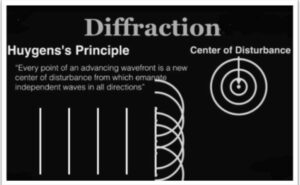Table of Contents
The Huygens–Fresnel principle is an analytical method used to solve wave propagation issues in the far-field limit, near-field diffraction, and reflection.
Important Concepts
Diffraction and the Huygens Principle
Each point on the light wave inside the aperture can be seen as a source, resulting in a circular wave that promulgates outward from the aperture. As a result, the aperture generates a new wave origin that propagates as a circular wavefront. The wavefront’s centre has a higher intensity than the edges, which have a lower intensity. This explains the visible diffraction pattern and explains why no perfect image of the aperture is displayed on a screen. This phenomenon can be seen in everyday life. The sound of someone calling to you from another room looks like it’s coming from the doorway.
Huygens Principle Advantages and Disadvantages
Advantages:
- Huygens’s notion verified light reflection and refraction.
- Huygens established concepts such as light diffraction and interference.
Disadvantage:
- Huygens’ approach did not explain concepts like light emission, light absorption, or light polarisation.
- The photoelectric effect was not explained by Huygens’ premise.
The Huygens Principle also termed the Huygens–Fresnel Principle emphasizes the wave propagation behaviour as follows:
- Secondary sources generate wavelets that are comparable to the original source’s wavelets.
- The new wavefront is determined by the general tangent on the wavelets in the forward plane at any given time.
- The total of the spherical wavelets is the wavefront.

Significance of Huygens principle in the IIT JEE exam
The Huygens principle is one of the most important principles in physics and is extensively used in the IIT JEE exam. The principle states that every point on a wavefront is a source of secondary waves. These secondary waves then propagate in all directions and merge with the other waves to form the wavefront. This principle is used to calculate the wavefronts of light and other waves.
The Huygens principle is important in the IIT JEE exam as it is used to solve problems related to waves. The principle can be used to calculate the wavefronts of light and other waves. It can also be used to calculate the interference patterns of waves. The principle is also used in the analysis of optical instruments.
FAQs
When does light react like a wave and when does it behave like a particle?
When light interacts with things with wavelengths several times bigger than its own, it behaves as a wave. When light interacts with objects that are comparable to or smaller than its wavelength, it appears as a particle.
Is diffraction to blame for your shadow's fuzzy edges?
The course of light waves at sharp edges is bent by diffraction. The shadow barrier is blurred as some light is diffused into the area where we would expect to find darkness.







